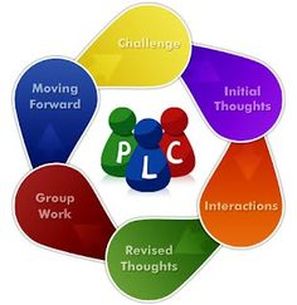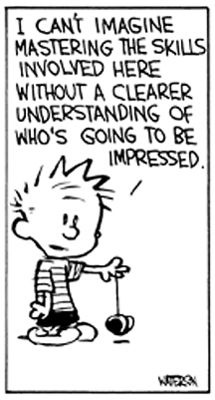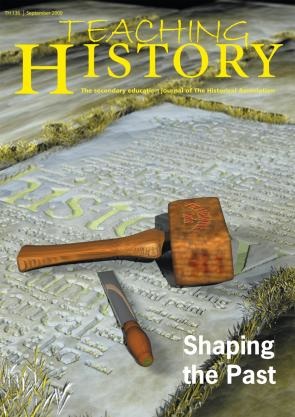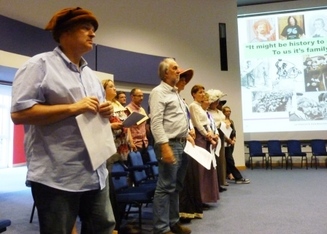I am not looking to draw specific lessons from this piece, but it may be of interest to schools, or indeed history departments, exploring the Professional Learning Community approach to developing their CPD. I have drawn a few key basic points from the literature for those with limited time:
- There is has been, and continues to be, a crisis over the provision of effective, subject focused, professional learning in teaching, and specifically in history departments.
- Professional learning can be effectively encouraged through Professional Learning Communities.
- Effective Professional Learning Communities are based on shared knowledge, routines and pedagogies. They are therefore ideally suited to departmental level professional learning and can place subject specific training back at the heart of teacher learning.
- Professional Learning Communities can be imposed from the top-down, but such PLCs are often resisted and therefore do not provide the benefits of genuinely organic PLCs.
- Professional Learning Communities which are cross-curricular or generic in their approaches generally enjoy less support than those which engage with a specific subject.
- When they are effective, Professional Learning Communities encourage teachers to be critical of their own practice and engage in activities which stretch and challenge their approaches to teaching. This in turn can have positvie effects of teachers' feelings of self-efficacy and student outcomes.
- The creation of networks of Professional Learning Communities has the potential to transform and improve the whole profession and can be done by anyone at any level.
Context
 A good diagram always makes something seem like a good idea in education.
A good diagram always makes something seem like a good idea in education. This literature review is a response to general criticisms of professional learning, outlined above, as well as a the 2011 Ofsted report, History for All (Ofsted, 2011), which set out the shortcomings of professional learning in history departments nationwide. The report noted that “an important issue [in recent history inspections] was the near-absence of appropriate subject training.” (Ofsted, 2011, p. 42) and went on to highlight the discovery that “…in the 65 schools visited…[subject training] was good or outstanding in only 15 of them.” (Ofsted, 2011, p. 42). The language here is vague; however the core point is hammered home with statistical precision. In one institution for example, there had been no subject specific professional development offered to staff for seven years (Ofsted, 2011). These findings clearly present stark challenges to history departments looking to improve their practice.
Over the last few years, many schools have made moves to bring their professional learning in-house (Woodcock, 2011). This approach is fairly common and it is unsurprising that this has come at a time when reducing budgets is paramount (Woodcock, 2011). In one case I explored in some detail, Robwood High (a high achieveing secondary - name changed) began a programme of establishing “Professional Learning Communities” (PLCs) to provide in-house CPD. The PLCs were given the purpose of fostering cross-curricular, collegiate approaches to CPD as a surrogate for bringing in external expertise. The PLCs at Robwood focused on improving teaching and learning across the school through a shared focus on Assessment for Learning (AfL). The challenge with this model of professional learning is twofold. First, the expertise must be available within the school already. Focussing too heavily on internal expertise runs the risk of encouraging conservatism and removing the challenge provided by external sources (Pendry, et al., 1998). The second issue whether or not such approaches to CPD allow all teachers to develop appropriately in response to their professional and subject specific needs.
Professional Learning Communities: A Brief Literature Review
Professional learning has been a much contested field of study (McCormick, et al., 2011). The term professional learning is often used in juxtaposition to the earlier use of CPD. The term itself builds on the works of educational theorists such as Stenhouse (1975), who argue that teachers needed to take control of their own professional understanding. Over the last three decades, Stenhouse's concept has found its way into the mainstream (McCormick, et al., 2011). However, the terms 'professional learning' and 'CPD' are often confused and used interchangeably. DfE documents for example refer to professional development as professional learning (2001; 2005). Whereas the latter is personal and holistic, the former is associated more with the specific acquisition of skills and knowledge (Pickering, et al., 2007). Whilst this may appear to be semantics, there is a distinct difference between CPD which has often been seen as a government imposed solution to the “problems” of education (Sugrue, 2004) and professional learning which is seen as developmental and tailored to the needs of individuals and learning communities (Guskey, 1995).

Much of the literature around professional learning has focused on its underlying purpose. Muijs et al. (2004) and Day & Sachs (2004) argue that professional learning has purposes as diverse as: delivering government initiatives; improving student outcomes; or indeed keeping teachers engaged with their practice. Pickering (2007) develops a different line, explaining that professional learning is primarily seen in terms of ‘teaching quality’ and its effectiveness is measured by educational outcomes. Such outcomes have tended to be reflected in students’ performance in tests and public examinations. Followers of this school of thought believe that PLCs should be used to establish “effective teaching practices…and improved student results.”(Mizell, et al., 2011, p. 12). However, these exam based outcomes are not necessarily a shared vision of what represents improvement (Sugrue, 2004) and tend to lead to CPD which focusses on ‘what works’ to achieve the said results (Pickering, et al., 2007). This kind of performativity leads to “…one-shot and one-size fits all workshops…” (Lock, 2006, p. 665) and is seen as being contrary to good professional learning (Pickering, et al., 2007). Sugrue (2004) builds on this argument and criticises government led CPD initiatives which place a premium on short term (exam based) goals and as such bombard teachers with new initiatives. Guskey (1995) and Loucks-Horsley & Stiegelbauer (1991) all support this stance, arguing that lasting change typically takes a minimum of three to five years to embed. Although it is tempting to rally to this call, it is also worth remembering that, for better or worse, public examination results do have a major impact on schools and their students. End results for students are paramount (Mizell, et al., 2011, p. 13) and get caught up in the ideological objections of the aforementioned authors would also risk ignoring one important purpose of professional learning.
One way to visualise other attempts to grapple with the purposes of CPD is to divide professional learning into three main categories: knowledge for practice, knowledge of practice, and knowledge in practice (Day & Sachs, 2004). These broad goals all lead to the development of the teacher from a competent professional into an inspirational one (Haydn, et al., 2008). More than this, the purpose of professional learning is seen to be a key driver in the perceptions of self-worth of the teacher (Mizell, et al., 2011). "If educators are not engaged throughout their careers in new learning experiences that enable them to better serve their students, both educators and students suffer.” (Mizell, et al., 2011, p. 12). A similar theme is echoed in an Iranian study from Karimi. Although the educational context is clearly very different, it is interesting to note the parallels with the US and UK studies already cited. Karimi (2011) explains how teachers’ beliefs about their ability to deliver learning were rooted in their ‘mastery experience’. Therefore, professional learning which develops content knowledge and pedagogical understanding,increased teachers’ efficacy judgments about themselves. These enhanced judgements had an impact on their persistence, drive and instructional success. Although much of Karimi’s work is based on perceptions rather than empirical data, there is a clear link between these perceptions and participation in high quality professional learning. Day and Sachs (2004) also show that professional learning can have a little appreciated role in renewing teacher enthusiasm. Although this is by no means conclusive, there does seem to be a strong correlation between teachers’ perceptions of what will help them improve, and effective professional learning.

Much of the available literature shows that effective professional learning is highly dependent on the motivation of the participants. Day & Sachs (2004) have suggested through various case studies that there is a divide between teachers who view CPD as demeaning and ill-conceived and those who see it as a vital part of their development. Teachers’ views of professional learning are vital as intrinsic motivation is seen as a necessary prerequisite for the learning process to happen (Csikszentmihalyi, 1997; Lave & Wenger, 1991). There is a symbiotic relationship between professional development, teacher motivation and a commitment to the learning process itself (Hunzicker, 2011). Professional learning, in the best case scenarios, “signals the importance of educators taking an active role in their continuous improvement and places emphasis on the learning.” (Mizell, et al., 2011). The issue of intrinsic motivation is picked up by the influential studies of Lave and Wenger, who argue that individuals must be motivated to learn through participation in a 'community of practice' (Lave & Wenger, 1991). Hunzicker (2011) and Day and Sachs (2004) argue that in order to elicit this intrinsic motivation, professional learning must consider teachers’ personal and professional needs. Day and Sachs’ (2004) work in particular is based on a wide range of international studies and takes a broad range of evidence into account in arriving at this conclusion. Motivation is clearly an importance factor for consideration in any professional learning endeavour. professional learning, much like education is something that “…equips the individual for commitment and action by increasing his understanding. It works most effectively not through authority but through attempting to generate responsibility and caring in a context of emancipation.” (Stenhouse, 1978, p. 741)
Structures and Integration
The structuring and integration of professional learning has a huge impact on its effectiveness. Sugrue notes that the main criticisms of CPD have arisen when it appears to have little actual impact on classroom practice, or when the learning is not sustained (Sugrue, 2004). The notion of professional learning as something which needs to be embedded in practice certainly enjoys wide support. Effectively planned professional learning “…engages teachers in learning opportunities that are job-embedded…” (Hunzicker, 2011, p. 4). New practices only survive if they fit into the teaching environment, novel practices will not be repeated unless they fit in somehow (Vasumathi, 2010). Under the best circumstances, teacher learning is made authentic through seamless integration into each school day (Fullan, 1995).
Mizell et al. take this idea of effectively planned professional learning one stage further again, arguing that the most important part of professional learning is “…recognizing and leveraging it systemwide, rather than using [it] solely as a strategy for individual growth.” (Mizell, et al., 2011, p. 13). It is important to note that Mizell et al. are promoting their own ‘Standards for professional learning’ developed in conjunction with ‘Learning Forward’, a company which seeks to promote and codify standardised PLCs. Therefore they have clear positionality in their discourse of the effectiveness of standardised PLCs as they are actively selling their ‘Standards’ as a commercial concern. For the ‘Learning Forward’ group, professional learning is part of a regional and even national drive to improve standards in the USA. Comparing this to a view from Malta, Bezzina also argues that schools are most effective when they look at controlling and addressing local and national agendas through their professional learning programmes (Bezzina, 2006). Bezzina’s study is an overview of current literature and is based in a very specific and small scale context, so may well be less generalisable to the UK. Both of these approaches have suggested a model of professional learning which is concerned with national policy goals, and is co-ordinated at a higher level.
However there is a sharp division over whether professional learning should be co-ordinated to fit in with national agendas. One major criticism comes from Brighouse’s ideological attack on centralised professional learning initiatives. He argues that the introduction of the National Curriculum in the UK meant that money was no longer spent on developing teachers in the broadest sense but rather on encouraging them to match the pedagogical intricacies of the new curriculum (Brighouse, 2008). This is a view shared by Sugrue (2004) who argues that government planning in CPD is driven by concern for economic competitiveness, rather than for improving students’ education. Hargreaves and Fullan (1992) have suggested that centrally imposed PLCs are models widely used as technocratic and bureaucratic controls masquerading as bottom up development. One possible solution is provided by Lave and Wenger who suggest that teachers should take control of their professional learning through the formation of ‘communities of practice’ which move beyond imposed models of CPD (Lave & Wenger, 1991). Such communities should develop out of individual and collective concerns. Rather than being imposed top down, professional learning should be a grassroots movement from the bottom up (Wenger, 1998). For Stigler and Hiebert, authors of the highly influential book ‘The Teaching Gap’ (1999), a teacher led model of professional learning is more than just allowing a degree of professional freedom, it is central to the improvement of teaching as a whole (Stigler & Hiebert, 1999). In their review of international evidence on teaching efficacy, they argue that only by giving teachers the freedom to structure their own learning will the ‘teaching gap’ between the USA and world leaders such as Japan be closed (Stigler & Hiebert, 2009). Although this is very specific to a set of US concerns, there are certainly shared issues which are applicable to making professional learning more effective inthe UK.
 Discussions of pedagogy or content - one means of developing a community of practice.
Discussions of pedagogy or content - one means of developing a community of practice. Another key debate in terms of effective professional learning relates to its focus and content. Muijs et al. (2004) identify five main models of professional learning: course focused, project focused, school focused, pupil focused and teacher focused. However, in evaluating professional learning at a school level, and thereby determining its effectiveness, these different purposes are seldom taken into account (Muijs, et al., 2004). It is therefore very difficult to accurately assess impact of professional learning and it is clear that much more work needs to be done in this area. Guskey points out that much of the ‘evaluation’ of ‘effectiveness’ has taken the form of summarising the activities carried out, or conducting basic and subjective ‘satisfaction’ questionnaires (Guskey, 2000, pp. 8-10). Empirical study and evaluation of the focus of professional learning is thin on the ground making value judgments about ‘best practice’ even more complicated.
The studies which have been conducted suggest there are three major areas of content for professional learning; “…the cognitive (especially subject knowledge), the affective (especially children’s development) and the pedagogical (especially the subtleties of learning)” (Brighouse, 2008, p. 315). This is broadly supported by Hunzicker (2011), Day and Sachs (2004) and Pickering (2007). Brighouse explains that “…the need for the teacher to be initially sufficiently equipped and subsequently and continually refreshed is significant.” (Brighouse, 2008, p. 315). In the context of history departments, Pendry et al. (1998) give three further specific examples of professional learning: a meeting to develop a scheme of work using internal expertise; the use of external support to aid a department; and the management of school context (Pendry, et al., 1998). Importantly they ignore models which have a school wide or policy focus. This may be due to the nature of the book as a guide for history departments; however it does give some indication that a shared understanding of the focus of professional learning is far from clear cut.
Although some lone voices have called for CPD which represents a “…cross curricular, cross phase, cross experience approach…” (Pickering, 2007, p. 213), there seems to be significant evidence that professional learning needs to focus on both instructional strategies as well as specific subject content (Hunzicker, 2011) (Pendry, et al., 1998) (Haydn, et al., 2008). However there is an issue that too much a focus on instructional strategies damages the professional freedom of teachers. Sugrue (2004) argues that current CPD policies create rationalised, simplified and prescriptive solutions. In an empirical study of CPD for K12 literacy lessons, Quick et al.(2009) and Karimi (2011) have shown that a focus on the instructional over subject content is likely to be less effective. Teachers, they argue, must have the knowledge to engage with and challenge student misconceptions. Hunzicker (2011) refutes Quick’s conclusions as isolated and ungeneralisable, possibly subject limited. Once again it is important to highlight that Quick’s US study and Karimi’s Iranian one might not be generalizable to a UK context. Yet a rejection of instructional models and an increasing focus on subject knowledge has been echoed in recent UK movements such as the growing importance of the Prince’s Teaching Institute, with its focus on subject specific professional learning. What is clear is that many teachers and educationalists are drawing parallels between the teacher focused model of professional learning and effectiveness.
 Does a discussion of history form a central part of a history department's practice?
Does a discussion of history form a central part of a history department's practice? Many of the arguments over effective professional learning have recently been subsumed into the wider theme of PLCs. Lave and Wenger (1991) argue that professional learning is a communal activity which relies less on what is learnt than the fact that the learning itself becomes a social activity to be conducted in ‘communities of practice’, something they term ‘situated learning’. Such communities when related to teaching represent a joint enterprise, continually renegotiated and understood by its members. They are bound by the mutual engagement of their members, and have a shared repertoire of resources, for example routines, products, vocabulary and pedagogies (Wenger, 1999). There is a growing body of evidence that, by shifting professional learning into networks such as these, teachers will able to break down barriers of conservatism and collaborate on projects to really benefit learning (Day & Sachs, 2004). Pachler has even linked this notion of the ‘community of practice’ to the concept of professionality, arguing that any new model of professionality must be judged in terms of teachers’ involvement in professional teams (Pachler, 2007). Again, the issue of the limited empirical evidence surfaces here. However Day and Sachs (2004) do provide a number of interesting international case studies which point to the positive impact of PLCs. In his Maltese example, Bezzina (2006) notes that the focus on teacher collaboration has had a huge impact on the way schools are run. This is particularly important as it implies the need for schools to be open to the challenges of PLCs as, “…[the] collegiality implied…is unlikely to even exist, let alone flourish, if the whole school ethos is inimical to it.” (Pendry, et al., 1998, p. 133).
There is also significant debate over the extent to which PLCs should be utilised as a central means of disseminating skills and knowledge. For Lave and Wenger the process of participation in a community is more important than what is being learnt (Lave & Wenger, 1991). As Guskey suggests in his analysis of teacher learning “…professional development is interactive when it engages teachers socially through regular opportunities to share problems, ideas, and viewpoints, and work together toward solutions…” (Guskey, 1995, p. 6). For Wenger, teachers are not busy acquiring models and structures to improve teaching but taking part in something which has a structure (Wenger, 1999). In being part of a community, learners have to participate in its socio-cultural practices (Wenger, 1998). This process of integrating into the learning community includes and subsumes the learning of knowledge and skills (Lave & Wenger, 1991). However there are two main caveats on the effectiveness of this model of learning: firstly that the knowledge must not be decontextualized; and secondly that new knowledge and learning must actually exist in these communities of practice (Tennant, 1998, p. 177). Tennant has argued that the approach taken by Lave and Wenger has led to an under-appreciation offormal structures of learning (Tennant, 1998). However, Hargreaves and Fullan (1992) caution that adding a more formal structure to the creation of these ‘communities of practice’ is top down, overtly masculine, bureaucratic and technocratic. This kind of ‘contrived collegiality’ is part of the problem of ineffective PLCs and not the solution as it makes collaboration compulsory rather than voluntary. PLCs must allow the balance of power to shift from the centre to the periphery if they are to be effective (Hargreaves & Fullan, 1992). This of course raises interesting issues for the models of professional learning which have a high level of centralised control (McCormick, et al., 2011).
 A community of practice? Image copyright Schools History Project
A community of practice? Image copyright Schools History Project Many professional learning initiavies in schools such as Robwood High actually fly contrary to much of the literature on effective Professional Learning Communities. Approaches which adopt top-down implementation of PLCs for the implementation of school-set driectives are often counter-productive (Hargreaves & Fullan, 1992). Yet, the wider research seems to suggest that the development of PLCs is a step in the right direction. Research would suggest that ‘communities of practice’ can implement change quickly,moving away from a cumbersome hierarchy (Wenger, 1998). history departments should certainly therefore continue to build their own communities of practice.
If PLCs are to be effectively developed as a method of professional learning in schools, the literature suggests that their purposes need to be carefully considered and planned for. In the example of Robwood High, the PLCs established were both implemented as a top-down policy, and set up with the specific purpose of promoting AfL in a generic, rather than subject specific context. As such, the impact of such groups is likely to be less pronounced than if they were subject specific, rather than cross-curricular (Hargreaves & Fullan, 1992). Work by Pendry et al. (1998) and Haydn et al. (2008) suggests that a departmental focus rather than a cross-curricular focus may well help teachers to see more value in the PLCs and give them a greater chance of success.
Another challenge comes in the form of the extent to which control of professional learning should be devolved. Pedder (2007) discusses walking a fine line between devolved control and unified direction. However Hargreaves and Fullan (1992) have written such an approach off as nothing more than contrived collegiality. The challenge therefore is for history departments to take a more active role in determining its own professional learning agenda; not simply identifying a CPD agenda, but establishing a functioning PLC. This should have a shared purpose, language and pedagogy; be subject specific; and involve a constant evolution of relations (Lave & Wenger, 1991). Such a task is no mean feat and will require the active participation of all members of the department. For this to happen, some significant work will need to be done in looking at building effective communities of practice with teachers at different stages of their careers (Haydn, et al., 2008).
Pedder’s study also highlights the fact that, despite a clear focus on learning and professional development, not all teachers have bought into the concept of a centrally directed PLC. In order for professional learning to be effective as demanded by Ofsted (2011), the PLCs must meet the high values shared by the majority of teachers for learning both inside and outside the classroom. The gulf identified by Pedder is one of unrealised values, rather than a rejection of professional learning. Effective PLCs need therefore to encourage all teachers to contribute to a long-term ‘departmental memory’ (Lave & Wenger, 1991). This in turn would help individuals to see a greater perceived value in the professional learning and therefore generate a greater motivation to participate (Hargreaves & Fullan, 1992). It seems that this could only be done through a system of collegiality which grows from the ground up and is genuinely interested in long term development of all the staff involved. Good examples of this can already be seen in effective and established history departments, and is a fundamental element of groups such as the Schools History Project or Historical Association.
In PLCs the profession has been granted an excellent means to achieve professional learning. However, differing ideologies determine that these means are being used for a range of purposes, measured against an even greater range of ‘desirable’ outcomes. At this point it seems that not all of these are conducive to effective professional development. Perhaps the main lesson to draw is that effective professional learning is something which “…equips the individual for commitment and action... It works most effectively not through authority but through attempting to generate responsibility and caring in a context of emancipation.”(Stenhouse, 1978, p. 741) There are many ways in which effective Professional Learning Communities can be built in schools. The challenge is for history departments to take the initiative in building their own communities of practice, rather than allowing such structures to be dictated to them.
Bibliography
Black, P. et al., 2003. Assessment for Learning. Putting it into Practice. Maidenhead: Open University Press.
Black, P. & Wiliam, D., 1998. Assessment and Classroom Learning. Assessment in Education, 5(1), pp. 7-74.
Brighouse, T., 2008. Putting Professional Development Centre Stage. Oxford Review of Education, 34(3), pp. 313-323.
Csikszentmihalyi, M., 1997. Flow and Education. NAMTA Journal, 22(2), pp. 2-35.
Day, C. & Sachs, J., 2004. International Handbook on the Continuing Professional Development of Teachers. Maidenhead: Open University Press.
DfEE, 2001. Learning and Teaching: A Strategy for Professional Development, London: DfEE.
DfES, 2005. Leading and Coordinating CPD in Secondary Schools, London: DfES.
Fullan, M., 1995. The Limits and the Potential of Porfessional Development. In: T. Guskey & M. Huberman, eds. Professional Development in Education: New Paradigms and Practices. New York: Teachers College Press, pp. 253-267.
Guskey, T., 1995. Professional Development in Education: In Search of the Optimal Mix. In: T. Guskey & M. Huberman, eds. Professional Development in Education: New Paradigms and Practices. New York: Teachers College Press, pp. 114-131.
Guskey, T., 2000. Evaluating Professional Development. Thousand Oaks, California: Corwin Press.
Hargreaves, A. & Fullan, M., 1992. Understanding Teacher Development. New York: Teachers College Press.
Haydn, T., Arthur, J., Hunt, M. & Stephen, A., 2008. Learning to Teach History in the Secondary School. 3rd ed. Abingdon: Routledge.
Hoyle, E., 1974. Professionality, Professionalism and Control in Teaching. London Education Review, 3(2), pp. 13-19.
Hoyle, E. & John, P., 1995. Professional Knowledge and Professional Practice. London: Cassell.
Hunzicker, J., 2011. Characteristics of Effective Professional Development: A Checklist. Professional Development in Education, 37(2), pp. 177-79.
James, M. et al., 2006. Learning How to Learn, in Classrooms, Schools and Networks: Aims, Design and Analysis. Research Papers in Education, 21(2), pp. 101-118.
Karimi, M., 2011. The Effects of Professional Development Initiatives on EFL Teachers' Degree of Self Efficacy. Australian Journal of Teacher Education, Volume 36, pp. 50-62.
Lave, J. & Wenger, E., 1991. Situated Learning. Legitimate Peripheral Participation. Cambridge: Cambridge University Press.
Lock, J., 2006. A New Image: Online Communities to Facilitate Teacher Professional Development. Journal of Technology and Teacher Education, 14(4), pp. 663-678.
Loucks-Horsley, S. & Stiegelbauer, S., 1991. Using Knowledge of Change to Guide Staff Development. In: A. Lieberman & L. Miller, eds. Staff Development for Education in the 90s: New Demands, New Realities, New Perspectives. New York: Teachers College Press, pp. 15-36.
McCormick, R., Fox, A., Carmichael, P. & Proctor, R., 2011. Researching and Understaning Educational Networks. New York: Routledge.
Mizell, H., Hord, S., Killion, J. & Hirsh, S., 2011. New Standards Put the Spotlight on Professional Learning. JSD, Volume 32, pp. 10-14.
Muijs, D., Day, C., Harris, A. & Lindsay, g., 2004. Evaluating CPD: An Overview. In: C. Day & J. Sachs, eds. International Handbook on the Continuing Professional Development of Teachers. Maidenhead: Open Univeristy Press, pp. 291-310.
Ofsted, 2006. Annual Report of Her Majesty's Chief Inspector of Schools, 2005-2006, London: OFSTED.
Ofsted, 2011. History for All: History in English Schools, 2007-10, London: Ofsted.
O'Neill, O., 2002. Called to Account. London, Reith Lectures.
Pachler, N., 2007. Teacher Development: a question(ing) of development. In: J. Pickering, C. Daly & N. Pachler, eds. New Designs for Teachers' Professional Learning. London: Institute of Education, pp. 242-268.
Pedder, D., 2007. Profiling Teachers' Professional Learning Practices and Values: Differences Between and Within Schools. The Curriculum Journal, 18(3), pp. 231-252.
Pendry, A., Husbands, C., Arthur, J. & Davison, J., 1998. History Teachers in the Making: Professional Learning. Buckingham: Open University Press.
Pickering, J., 2007. Teachers' Professional Development: not whether or what, but how. In: J. Pickering, C. Daly & N. Pachler, eds. New Designs for Teachers' Professional Learning. London: Institute of Education, pp. 192-218.
Pickering, J., Daly, C. & Pachler, N., 2007. New Designs for Teachers' Professional Learning. London: Institute of Education.
Quick, H., Holzman, D. & Chaney, K., 2009. Professional Development and Instructional Practice: Conceptions and Evidence of Effectiveness. Journal of Education for Students Placed at Risk, 14(1), pp. 45-71.
Stenhouse, L., 1975. An Introduction to Curriculum Research and Development. London: Heineman.
Stenhouse, L., 1978. Cultures, Attitudes and Education. Royal Society of Arts Journal, 125(1), pp. 735-45.
Stigler, J. & Hiebert, J., 1999. The Teaching Gap. New York: The Free Press.
Stigler, J. & Hiebert, J., 2009. Closing the Teaching Gap. Phi Delta Kappan, 91(3), pp. 32-37.
Sugrue, C., 2004. Rhetorics and realities of CPD across Europe: from cacophony towards coherence?. In: C. Day & J. Sachs, eds. International Handbook on the Continuing Professional Development of Teachers. Maidenhead: Open University Press, pp. 67-93.
Tennant, M., 1998. Psychology and Adult Learning. 2nd ed. London: Routledge.
Tripp, D., 2004. Teachers’ networks: a new approach to the professional development of teachers in Singapore. In: C. Day & J. Sachs, eds. International Handbook on the Continuing Professional Development of Teachers. Maidenhead: Open University Press, pp. 191-214.
Vasumathi, T., 2010. A Design for Professional Development of Teachers - Need for New Policy Framework. [Online]
Available at: http://www.eric.ed.gov/PDFS/ED512828.pdf
[Accessed 01 02 2012].
Wenger, E., 1998. Systems Thinker. [Online]
Available at: http://www.co-i-l.com/coil/knowledge-garden/cop/lss.shtml
[Accessed 3 March 2012].
Wenger, E., 1999. Communities of Practice. Learning, Meaning and Identity. Cambridge: Cambridge University Press.
Woodcock, S., 2011. Sticking with CPD?. Leader, 01 03.

 RSS Feed
RSS Feed
